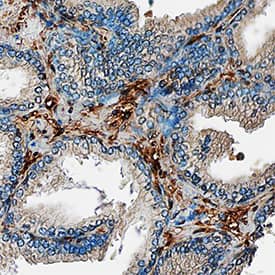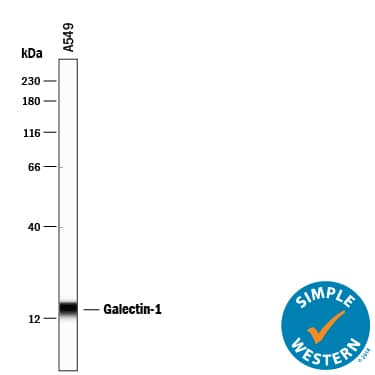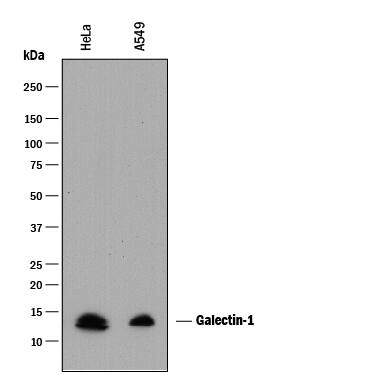Human Galectin-1 Antibody
R&D Systems, part of Bio-Techne | Catalog # MAB1152

Key Product Details
Species Reactivity
Validated:
Cited:
Applications
Validated:
Cited:
Label
Antibody Source
Product Specifications
Immunogen
Met1-Asp135
Accession # P09382
Specificity
Clonality
Host
Isotype
Scientific Data Images for Human Galectin-1 Antibody
Detection of Human Galectin-1 by Western Blot.
Western blot shows lysates of HeLa human cervical epithelial carcinoma cell line and A549 human lung carcinoma cell line. PVDF membrane was probed with 2 µg/mL of Mouse Anti-Human Galectin-1 Monoclonal Antibody (Catalog # MAB1152) followed by HRP-conjugated Anti-Mouse IgG Secondary Antibody (Catalog # HAF018). A specific band was detected for Galectin-1 at approximately 14 kDa (as indicated). This experiment was conducted under reducing conditions and using Immunoblot Buffer Group 1.Galectin‑1 in Human Prostate.
Galectin-1 was detected in immersion fixed paraffin-embedded sections of human prostate using Mouse Anti-Human Galectin-1 Monoclonal Antibody (Catalog # MAB1152) at 15 µg/mL overnight at 4 °C. Tissue was stained using the Anti-Mouse HRP-DAB Cell & Tissue Staining Kit (brown; Catalog # CTS002) and counterstained with hematoxylin (blue). Specific staining was localized to stromal cells. View our protocol for Chromogenic IHC Staining of Paraffin-embedded Tissue Sections.Detection of Human Galectin‑1 by Simple WesternTM.
Simple Western lane view shows lysate of A549 human lung carcinoma cell line, loaded at 0.2 mg/mL. A specific band was detected for Galectin‑1 at approximately 16 kDa (as indicated) using 100 µg/mL of Mouse Anti-Human Galectin‑1 Monoclonal Antibody (Catalog # MAB1152) . This experiment was conducted under reducing conditions and using the 12-230 kDa separation system.Applications for Human Galectin-1 Antibody
Immunohistochemistry
Sample: Immersion fixed paraffin-embedded sections of human prostate
Simple Western
Sample: A549 human lung carcinoma cell line
Western Blot
Sample: HeLa human cervical epithelial carcinoma cell line and A549 human lung carcinoma cell line
Reviewed Applications
Read 1 review rated 5 using MAB1152 in the following applications:
Formulation, Preparation, and Storage
Purification
Reconstitution
Formulation
Shipping
Stability & Storage
- 12 months from date of receipt, -20 to -70 °C as supplied.
- 1 month, 2 to 8 °C under sterile conditions after reconstitution.
- 6 months, -20 to -70 °C under sterile conditions after reconstitution.
Background: Galectin-1
The galectins constitute a large family of carbohydrate-binding proteins with specificity for N-acetyl-lactosamine-containing glycoproteins. At least 14 mammalian galectins, which share structural similarities in their carbohydrate recognition domains (CRD), have been identified to date. The galectins have been classified into the prototype galectins (-1, -2, -5, -7, -10, -11, -13, -14), which contain one CRD and exist either as a monomer or a noncovalent homodimer; the chimera galectins (galectin-3) containing one CRD linked to a nonlectin domain; and the tandem-repeat galectins (-4, -6, -8, -9, -12) consisting of two CRDs joined by a linker peptide. Galectins lack a classical signal peptide and can be localized to the cytosolic compartments where they have intracellular functions. However, via one or more as yet unidentified non-classical secretory pathways, galectins can also be secreted to function extracellularly. Individual members of the galectin family have different tissue distribution profiles and exhibit subtle differences in their carbohydrate-binding specificities. Each family member may preferentially bind to a unique subset of cell-surface glycoproteins.
Galectin-1, also known as L-14, BHL and galaptin, is a monomeric or homodimeric prototype galectin that is expressed in a variety of cells and tissues including muscle, heart, liver, prostate, lymph nodes, spleen, thymus, placenta, testis, retina, macrophages, B cells, T cells, dendritic cells, and tumor cells. It preferentially binds laminin, fibronectin, 90K/Mac-2BP, CD45, CD43, CD7, CD2, CD3, and ganglioside GM1. Galectin-1 modulates cell growth and proliferation, either positively or negatively, depending on the cell type and activation status. It controls cell survival by inducing apoptosis of activated T cells and immature thymocytes. It modulates cytokine secretion by inducing Th2 type cytokines and inhibiting pro-inflammatory cytokine production. Galectin-1 can also modulate cell-cell as well as cell-matrix interactions and depending on the cell type and developmental stage, promote cell attachment or detachment. Galectin-1 has immunosuppressive and anti-inflammatory properties and has been shown to suppress acute and chronic inflammation and autoimmunity. Human and mouse galectin-1 share about 88% amino acid sequence similarity.
Alternate Names
Gene Symbol
UniProt
Additional Galectin-1 Products
Product Documents for Human Galectin-1 Antibody
Product Specific Notices for Human Galectin-1 Antibody
For research use only


